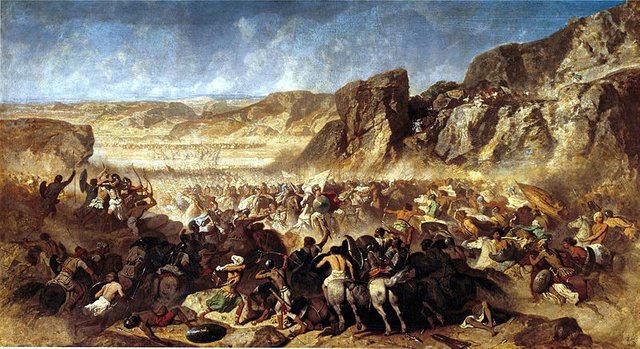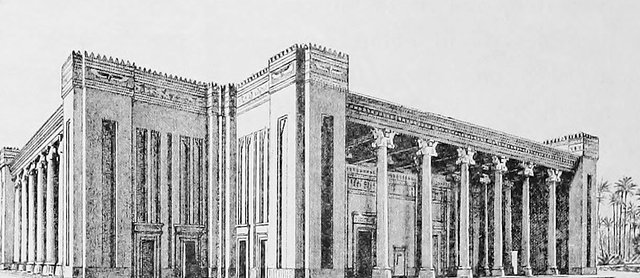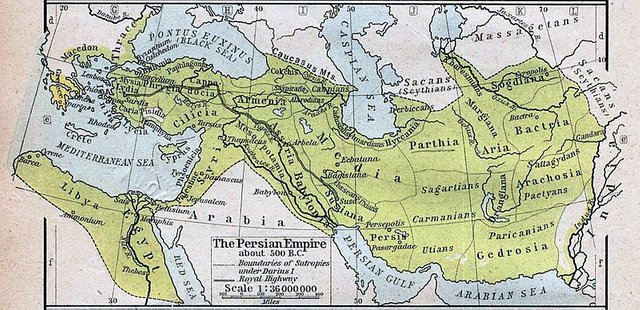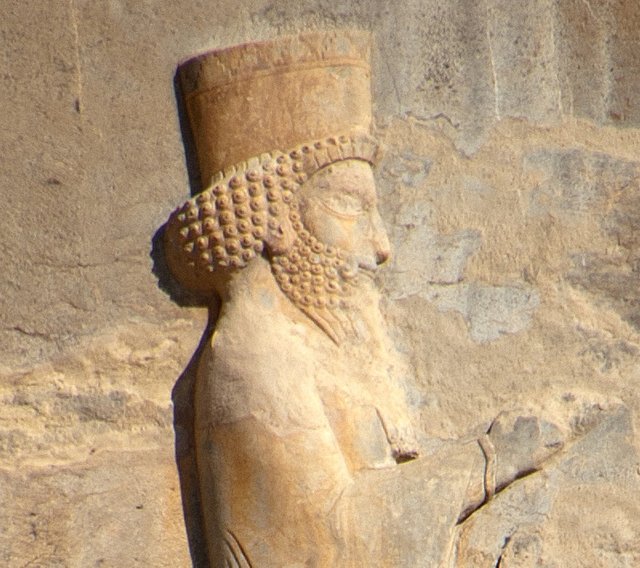
The Restoration of Ancient History is a paper delivered in November 1994 by Gunnar Heinsohn, Professor Emeritus at the University of Bremen in Germany, at a symposium in Portland, Oregon. This paper questions the conventional chronology of ancient history and offers in its place a radical reconstruction—the so-called Short Chronology, of which Heinsohn is the principal architect. In this series of articles, we are taking a closer look at the evidence cited in this paper in favour of Heinsohn’s new chronology.
Assyrians, Medes, Persians
In this article we will continue our study of Part 2 of Heinsohn’s lecture: The sequence of ancient empires with the center in Assyria as it was taught by Greek historians since the time of Hekateios (-560/550 to -500/494). In this section, Heinsohn is concerned with Upper Mesopotamia—the region centred on the River Tigris and known to Classical historians as Assyria. He points out that these historians were in broad agreement that this region had once formed the nucleus of three successive empires—those of the Assyrians, the Medes, and the Persians—prior to the conquests of Alexander the Great.
Based on these accounts, Heinsohn recognizes four periods in the history of Assyria before Alexander the Great:
| Dates BCE | Period |
|---|---|
| 1150-750 | Early Assyrians |
| 750-620 | Assyrian Empire |
| 620-540 | Empire of the Medes |
| 540-330 | Persian Empire |
In the preceding article, we looked at Herodotus’s scanty account of Assyrian history. In this article, we are going to take a brief look at Assyrian history as it was recorded by another Classical historian, Ctesias of Cnidus.

Ctesias of Cnidus
Ctesias of Cnidus was born in the Greek colony of Cnidus in Caria. He is alleged to have served for seventeen years as a physician at the court of the Persian Emperor Artaxerxes II Memnon (404-359). He was present at the Battle of Cunaxa, between Artaxerxes II and his brother Cyrus the Younger. Ctesias claims to have had access to the royal archives—no longer extant—during his lengthy service at the Persian court:
Such an interval must naturally have given him opportunities of acquiring statistical and geographical information concerning the provinces of that empire superior to what had been possessed by any other Greek. Nor did he neglect to avail himself of the facilities thus presented to him. Among the works with the composition of which he occupied himself after his return to Greece (b.c. 398) we find mention of a treatise on the revenues of the Persian Empire—which it would have been interesting to compare with the information furnished us by Herodotus upon the same subject—as well as of two professedly geographical treatises—the one on rivers, the other on mountains. Both of these are totally lost, and a meagre abstract by Photius is all that remains to us of his principal work, the Persian history. Of the historical merits of the “Persica” in general, it does not fall within our province to speak. (Bunbury 338-339)
Ctesias’ claim to have served at the Persian court for seventeen years has been disputed. If he served under Artaxerxes II and returned to Greece around -398, he can only have been at court for six or seven years at most (404-398). Perhaps he was royal physician for just the last six or seven years of a much longer service, or perhaps he had been tending Artaxerxes for ten years prior to his coronation (Nichols 12-14, Almagor 13).

As Bunbury states, Ctesias was the author of several works, all of which are lost:
A treatise on rivers.
A treatise on the Persian revenues.
An account of India, entitled Indica.
A history of Assyria and Persia from earliest times to -398. Comprising 23 books, it was entitled Persica.
Of the Persica, only fragments and abridgments are extant, but it is clear that Ctesias’s account of Assyrian and Median history is at odds with that of Herodotus. He was cited by the opponents of Herodotus to the latter’s discredit, but today he is looked upon as a very unreliable source (Stronk 25, Nichols 8).
In his essay How to Write History, the Assyrian-born Greek satirist Lucian does not reposit much faith in Ctesias:
The historian’s one task is to tell the thing as it happened. This he cannot do, if he is Artaxerxes’s physician, trembling before him, or hoping to get a purple cloak, a golden chain, a horse of the Nisaean breed, in payment for his laudations. (Fowler 128)
Plutarch, in his Life of Artaxerxes II Memnon, damns Ctesias with faint praise:
But it is unlikely that Ctesias, even if he has put into his work a perfect farrago of extravagant and incredible tales, should be ignorant of the name of the king at whose court he lived as physician to the king’s wife and mother and children. (Perrin 129)
In a recent reappraisal of his works, Jan P Stronk of the University of Amsterdam sees Ctesias’s writings not as history in our sense of the word, but rather:
as a forerunner of a new literary genre (culminating in the classical novel) mixing historical fact with fictitious elements. It is only because of the lack of a proper word in antiquity to describe this genre that the term ‘history’ was applied to his work as well. (Stronk 25)
Klaus Karttunen has a similar opinion:
Let it now be stated: Ctesias was no critical scholar, nor even a historian in our sense of the word. He was intentionally entertaining, he collected marvels and curiosities ... and, for his Persian history, rumours. He wrote for the contemporary audience and did not expect to be read 500 years later, not to speak of scholars living more than 2000 years later. He is not a good source, but as we so often have no better sources, even he is of value for our studies. (Karttunen 636)
None of this is likely to fill the modern researcher with much confidence, but let us hear Ctesias’s account of Assyrian history before we dismiss it. Happily, all extant fragments of Ctesias’s works have now been translated into English by Andrew Nichols (2008):
The most famous work of Ctesias, both in antiquity and today, is his Persika written in 23 books. The work began with the Assyrian Empire and covered events up to the point of Ctesias’ return to Greece in 398/397 B.C.E. His history focuses more on folk tales and court gossip than on the political events of the day. However, while his method of historiography can be frustrating for modern scholars, his work is of vital importance for the study of history of the Achaemenid Empire. (Nichols 17)

According to Nichols’s numbering system, forty-four fragments survive of the Persica, several of which have been preserved in more than one source:
| Books | Subject | Fragments |
|---|---|---|
| Books 1-3 | History of Assyria | F1a-F4 |
| Books 4-6 | History of the Medes | F5-F8d |
| Books 7-23 | History of Persia | F9-F44b. |
Books 1-6 are sometimes referred to as the Assyriaca and may have circulated independently of the remaining books. F33a gives perhaps the most succinct summary of Ctesias’s Persica:
Tradition mentions five kingdoms ... The first was the Assyrian kingdom which was founded by Ninus, the first king, and dissolved under the last king Sardanapallus having lasted for 1,450 years. The second kingdom was that of the Medes which lasted from its first king Arbaces to the reign of its final king Astyages for a period of 470 years (Herodotus claims it lasted for 128 years). The third kingdom was the Persian Empire, which was founded by Cyrus, the son of Cambyses, until Artaxerxes, the son of Darius, covering a period of 215 years. Ctesias writes about these times until the reign of Artaxerxes which he reaches in the twenty-third book of the Persika. (Nichols 109)
According to another fragment, F1b, the Assyrian Empire only endured for 1360 years (Nichols 67). Also, the lengths of the reigns of the first eight Median Emperors only amounts to 282 years. The length of the reign of the ninth and final Median Emperor, Astyages, is not preserved in any of the fragments. In Herodotus, he is assigned a reign of 35 years.
Ctesias concluded the Persica with a king-list of all the rulers of Assyria, from Ninus to Artaxerxes II. Unfortunately, this has only been preserved in a fragmentary form. It includes the first three Assyrian rulers:
- Ninus (56 years).
- Semiramis (42 years).
- Ninyas.
Three later Assyrian rulers:
- Teutamos, who was contemporary with the Trojan War.
- Beleous, who was the last member of the dynasty of Ninus.
- Beletaras, who founded a new dynasty.
The last Assyrian ruler:
- Sardanapallus.
The nine Emperors of the Medes:
- Arbaces (28 years).
- Maudaces (50 years).
- Sosarmus (30 years).
- Artycas (50 years).
- Arbianes (22 years).
- Artaios (40 years).
- Artines (22 years).
- Astibaras (40 years).
- Astyages.
The first ten rulers of the Persian Empire:
- Cyrus II (30 years).
- Cambyses II (18 years).
- Tanyoxarkes (Sphendatates the Magus) (7 months).
- Darius I (31 years).
- Xerxes I.
- Artaxerxes I (42 years).
- Xerxes II (45 days).
- Sekyndianos (6 months and 15 days).
- Darius II Ochus (35 years).
- Artaxerxes II Memnon (7 years and counting).

Comparison with Herodotus
Ctesias agrees with Herodotus that three Empires ruled over Assyria before Alexander the Great: Assyrian, Median and Persian. As far as the first two of these are concerned, however, their accounts have little in common:
Herodotus’s Assyrian Empire lasted for about 520 years, while Ctesias’s endured for almost three times as long.
Herodotus records just four Median Emperors, while Ctesias has nine. The only name common to both is that of the last Emperor, Astyages. Note that if Sosarmus is assigned 28 years rather than 30, then the first eight emperors have reign-lengths of 28, 50, 28, 50, 22, 40, 22, 40. This suggests that there has been some duplication. Furthermore, in Herodotus’s scheme, the second and third emperors reigned for 22 and 40 years respectively (Dindorf & Müller 43):
| Herodotus | Ctesias I | Ctesias II |
|---|---|---|
| - | Arbaces (28) | Sosarmus (30) |
| Deioces (53) | Artycas (50) | Maudaces (50) |
| Phraortes (22) | Arbianes (22) | Artines (22) |
| Cyaxares (40) | Artaios (40) | Astibaras (40) |
| Astyages (35) | Astyages | - |
Herodotus assigns 128 years to the Empire of the Medes—150 years if we include the whole of the first ruler Deioces’ reign. According to Ctesias, the empire had already lasted 282 years when Astyages ascended the throne.
Herodotus interrupts the Empire of the Medes with a period of 28 years during which the Scythians were the dominant nation in Assyria. Ctesias does record a war between the Medes and the Saka (Scythians) during the 40-year reign of Astibaras, the eighth ruler of Media. We are only told that it lasted many years (Nichols 78).
Ctesias tells us explicitly that Cyrus the Great belonged to a Persian tribe called the Mardians and was not related to Astyages. Herodotus does mention this tribe (1:125, Godley 165) but he claims that the Achaemenids belonged to another tribe, the Pasargadae, and that Cyrus was also the grandson of Astyages through his mother Mandane.
The sequence and reign-lengths of the Persian Emperors are more or less the same in Herodotus and Ctesias. The younger brother of Cambyses II, who was briefly impersonated on the throne by an imposter, is called Smerdis by Herodotus and Tanyoxarkes by Ctesias, while Darius the Great’s monument at Behistun calls him Bardiya. The imposter’s name is Smerdis in Herodotus and Sphendadates in Ctesias, and Gaumata at Behistun. Neither Herodotus nor Ctesias gives us a reign-length for Xerxes I. Today, mainstream historians say that he ruled from -486 to -465.
The following timeline assumes that Xerxes reigned from -486 to -465 and that Ctesias assigned a 35-year reign to Astyages and a duration of 1360 years to the Assyrian Empire:

Later Classical Historians
Many of the later Classical historians borrowed their Assyrian history from Herodotus or Ctesias. Diodorus Siculus favoured Ctesias’s account—he is, in fact, one of our principal sources for Ctesias (Stronk 27)—as did Xenophon and the Byzantine scholar John Tzetzes. Plutarch used Ctesias extensively for his Life of Artaxerxes in spite of his reservations (Almagor 10). Herodotus, however, was preferred by historians of later centuries: Henricus Stephanus’s favorable opinion of Ctesias in the late 16th century was very much the exception (Karttunen 638). Once archaeologists began to recover original Assyrian artifacts from the ground—including written records—Ctesias’s reputation as a reliable historian suffered a decline from which it has never recovered.
Much more could be said about the discrepancies between the two schools of history—Herodotean and Ctesian—and about the historicity of the various characters mentioned by them, but for Gunnar Heinsohn’s purposes the most important point is that all the Classical historians, including Herodotus and Ctesias, agreed that Assyria had formed the nucleus of three successive empires prior to the conquests of Alexander the Great: those of the Assyrians, the Medes and the Persians, with possibly a period of Scythian domination interrupting the Empire of the Medes.
In the next article in this series, we will see whether this historical paradigm is reflected on the ground in the archaeology of Assyria.
To be continued ...
References
- Juan Almagor, Ctesias and the Importance of His Writings Revisited, Electrum, Volume 19, pp 9-40, Cracow (2012)
- Edward Herbert Bunbury, A History of Ancient Geography among the Greeks and Romans, Volume 1, John Murray, London (1879)
- Wilhelm Dindorf, Karl Müller (editors), Herodotus: Herodoti Historiarum Libri IX. Recognovit et commentationem de dialecto Herodoti praemisit Guilielmus Dindorfius. Ctesiae Cnidii et chronographorum, Castoris, Eratosthenis, etc., fragmenta, dissertatione et notis illustrata a Carolo Müllero, Ambrose Firmin Didot, Paris (1858)
- Henry Watson Fowler & Francis George Fowler (translators), The Works of Lucian of Samosata, Volume 2, The Clarendon Press, Oxford (1905)
- Alfred Denis Godley (translator), Herodotus, Volume 1, The Histories, Books 1-2, Loeb Classical Library, Harvard University Press, Cambridge MA (1920)
- Gunnar Heinsohn, Catastrophism, Revisionism, and Velikovsky, in Lewis M Greenberg (editor), Kronos: A Journal of Interdisciplinary Synthesis, Volume 11, Number 1, Kronos Press, Deerfield Beach, FL (1985)
- Gunnar Heinsohn, The Restoration of Ancient History, Mikamar Publishing, Portland, OR (1994)
- Gunnar Heinsohn, Die Sumerer gab es nicht [The Sumerians Never Existed], Frankfurt (1988)
- Gunnar Heinsohn, Heribert Illig, Wann lebten die Pharaonen? [When Did the Pharaohs Live?], Eichborn Verlag, Frankfurt (1990)
- Gunnar Heinsohn, M Eichborn, Wie alt ist das Menschengeschlecht? [How Old Is Mankind?], Mantis Verlag, Gräfelfing, Munich (1996)
- Klaus Karttunen, Ctesias in Transmission and Tradition, Topoi Orient-Occident, Volume 7, pp 635-646, Éditions de Boccard, Paris (1997)
- Andrew Nichols, The Complete Fragments of Ctesias of Cnidus: Translation and Commentary with an Introduction, University of Florida, Gainesville, FL (2008)
- Bernadotte Perrin, Plutarch’s Lives, Volume 11, Loeb Classical Library, Harvard University Press, Cambridge, MA (1954)
- Jan P Stronk, Ctesias of Cnidus: A Reappraisal, Mnemosyne, Fourth Series, Volume 60, Fascicle 1, pp 25-58, Brill, Leiden (2007)
Image Credits
- Gunnar Heinsohn: Wikimedia Commons, © Freud, Creative Commons License
- Battle of Cunaxa: Adrien Guignet (artist), Louvre, Paris, Public Domain
- The Apadana at Susa: Gaston Maspero, Archibald Henry Sayce, History of Egypt, Chaldea, Syria, Babylonia, and Assyria, Volume 9, p 270, Grolier Society, London (1903), Public Domain
- Artaxerxes II Memnon: Tomb of Artaxerxes II at Persepolis, © Bruce Allardice, Creative Commons License
- The Persian Empire: William Robert Shepherd, The Historical Atlas, p 8, The Colonial Offset Co, Inc, Pikesville, MD (1923), Public Domain
Online Resources
